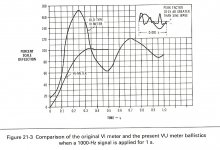Hey guys, I'm currently fixing and cleaning an old Yamaha MC1602 Mixer for a friend. One of the analogue VU meters is not working (among other things), so I was looking at getting a new meter to replace it. I have found one, but I am not sure if it is right for the job. Here is the link:
Buy Analogue Panel Ammeters Meter,panel,VU,moving coil,SQ10S Anders Electronics SQ10S online from RS for next day delivery.
I don't know much about VU meters, so I would appreciate all the help you guys could give me. Cheers.
Buy Analogue Panel Ammeters Meter,panel,VU,moving coil,SQ10S Anders Electronics SQ10S online from RS for next day delivery.
I don't know much about VU meters, so I would appreciate all the help you guys could give me. Cheers.
The SQ meter literature state that they are VU meters, but that could just refer to the scale. I did not see anything about the ballistics of the movement. Also, you do not know if the original movements are ballistically (is that a word?) correct or if the response is realized in the electronics. Than is also the question of the impedance matching of the meters...
Go with the original or replace both and use the good meter as a reference for alignment. E
Go with the original or replace both and use the good meter as a reference for alignment. E
Yes, you could use that analogy.
All meters are ammeters. A small current though the coil will cause the meter to move.
Adding resistors in series with the meter turns it into a voltmeter. Adding resistors in parallel will turn it into an ammeter.
They are all linear though. It is the dial which makes them non-linear.
All meters are ammeters. A small current though the coil will cause the meter to move.
Adding resistors in series with the meter turns it into a voltmeter. Adding resistors in parallel will turn it into an ammeter.
They are all linear though. It is the dial which makes them non-linear.
Last edited:
ACtually the mechanics matter too. A voltmeter per se just reads out some voltage. A VU meter, in contrast, is supposed to indicate in real time a changing signal. In the old days, they made special meters for VU display that had a certain mechanical response, a certain inertia, so they didn't fly around and were better able to indicate more of an average while still showing peaks. SO replaing a 50ua VU meter with a plain old 50ua meter movement might not be as accurate.
Discussions of VU meters usually breaks down into camps debating impedances etc. SO a difference must be made between a VU meter as a piece of equipment and a VU meter as in the indicator on the panel of some unit. The piece of equipment should have a certain impedance and move in a predictable manner. The VU panel meter is part of an overall circuit which determines all those things and as such is not so constrained.
Discussions of VU meters usually breaks down into camps debating impedances etc. SO a difference must be made between a VU meter as a piece of equipment and a VU meter as in the indicator on the panel of some unit. The piece of equipment should have a certain impedance and move in a predictable manner. The VU panel meter is part of an overall circuit which determines all those things and as such is not so constrained.
Yamaha got back to to me, and said that the part is no longer available, just as I suspected.
I measured the resistance of the coil of the faulty meter, and the other meters, they are 650 ohms. The meter that I attached a link for is 600 ohms, I have found another meter, of the same product range, but different model, that is 650 ohms. Will this work? I'm thinking about just getting it and trying it anyway. Thanks again.
I measured the resistance of the coil of the faulty meter, and the other meters, they are 650 ohms. The meter that I attached a link for is 600 ohms, I have found another meter, of the same product range, but different model, that is 650 ohms. Will this work? I'm thinking about just getting it and trying it anyway. Thanks again.
- Status
- This old topic is closed. If you want to reopen this topic, contact a moderator using the "Report Post" button.
- Home
- Design & Build
- Parts
- Old Yamaha VU meters
